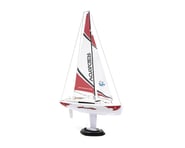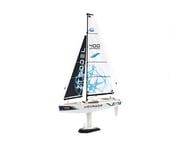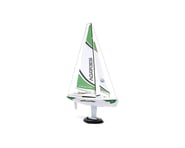I got the blue Voyager 400 last week. My first RC sailboat. I've played with small RC powerboats, but they burn through batteries, and I wanted something more relaxing. I've always been intrigued by sail, so I thought I'd try this.
I must say, I'm glad I got the 400 (40cm), not the 280 (28cm), version. The 400 is about 15 inches, so it is small enough to sail in our swimming pool, but big enough to use in our neighborhood pond. Good size, but of course now I want a bigger one. I've got a 95cm sailboat on order already. But I'll keep this one for our pool, and for teaching family and friends. Worth the low price.
Things I like...
1) It comes fully assembled, and I mean fully. The only assembly required is to attach two sail corners that are loose for shipping to avoid damage. That takes about 30 seconds. Note that the sail corner clips are tiny, and hard to see. They are "pinchers", meaning they have a circle with a gap at the bottom. It is a bit confusing at first on how to install it. It is actually VERY easy. You just press the pincher onto the plastic boom and it snaps into place. There are 3 separate connection points. Use the close one for higher winds, the middle for regular winds (2 to 6 mph), and the farthest one for light winds. I just leave it on the closest one, since I like to sail in our pond that gets fairly windy.
2) Battery life is awesome. Just put some AA batteries in the remote controller. The included tiny lipo battery sticks into a special charging slot on the back of the controller. It takes about 30 minutes to charge the lipo battery, which then lasts for hours of sailing. You use the lipo battery in the boat itself. It powers the little servos and the remote receiver. I thought it was a tiny usb stick, but it is a battery. Tiny, but lasts so long.
3) Sailing the boat is very easy. I learned in a few minutes, and have since taught my wife, son, and a neighbor. They all picked it up in a few minutes. If you don't have someone to show you, it might take a bit longer, or maybe watch some rc sailing tutorials online.
4) Boat is well made and pretty rugged. I've run aground and tapped side of pool and pond. No damage.
5) Remote control range is great. My eyes are fairly sharp, but the remote range is way better than my eyes. So I either walk along edge of pond with boat, or turn it back towards me. Otherwise, it gets too hard to see what it is doing.
6) Two color options, so I can get both and race with family or friends.
Things I don't like... (picky picky)
1) It can eventually get some water in it, especially if you run aground and get stuck on edge of a pond or something. No worries though, just open the hatch and dump the water. When you put it away, leave the hatch ajar so air can circulate and dry it out.
2) I wish the keel bulb weight was a little bigger and heavier, but not sure that would be possible with this size boat. It tends to get pushed over a bit in stronger winds, so that's why I want a bigger boat now. Other than that, no complaints. It is just a function of a smaller, less expensive, entry level boat.
How to sail it? Here's what you need to know...
1) The left stick controls the sails/sheets. Pull back to tighten the sails, and push forward to let them out. If the boat is standing straight up, or bobbing, or the sail is fluttering, then the sail is probably too loose. Pull back slowly to tighten the sail, until you see power from the sail causing boat to heal over. Fine tune the sail in or out for max speed. If boat heels over too far, or lays down, you might need to let some sail out. Sailing at an angle of about 20 to 40 degrees healed over is probably the sweet spot, where you are getting a lot of power, but not so far over that you are taking on water or losing control.
2) The right stick controls the rudder. Push left to turn left. Push right to turn right. Don't sail directly into the wind, or you'll stall ("in irons") and have to be patient while your boat slowly turns to regain wind power. Best to sail back and forth, slightly into the wind, working your way upwind on each leg of sail. Then once you get upwind, turn down wind and loosen the sails up. If you're careful, you get get them to "butterfly" or "wing on wing" where one sail is to one side, while the other is to the other side. It can be hard to control in a straight line like this for long, but while you've got it butterflied, it really goes. Lots of fun. Then turn and work your way upwind again.
3) If wind is too strong, boat will kind of get locked into one direction. It will be healed over to far to turn into or away from the wind. So be careful and always sail in an enclosed area, like a small lake or pond. That way, it will reach a shore, and you can go retrieve it. If you sail in a large open body of water, with high wind, the boat may get locked up and just sail away out of sight.
4) You may notice sometimes the boat curves sharply towards the wind. This means the sail has way too much power, such as if a gust of wind comes. You can find the edge of the power envelope, where wind wants to turn boat into wind, while you also use rudder to steer away from wind. If you get this right, boat will cruise fast about 45 degrees off the wind. Lots of fun.
That's about it. Really great boat for trying out RC Sailing. I loved it, and already want a bigger boat. So that's the biggest downside.
I'd probably not recommend the smaller Voyager 280 (28cm) version, since it is even smaller/lighter, and not much cheaper.
So, if you want a good starter boat, to try the RC Sailing hobby, this is a great boat to start with.
Enjoy!








